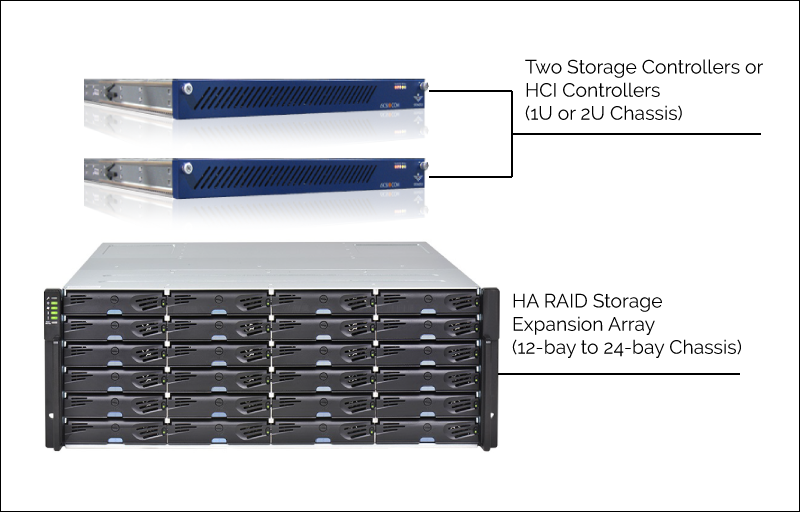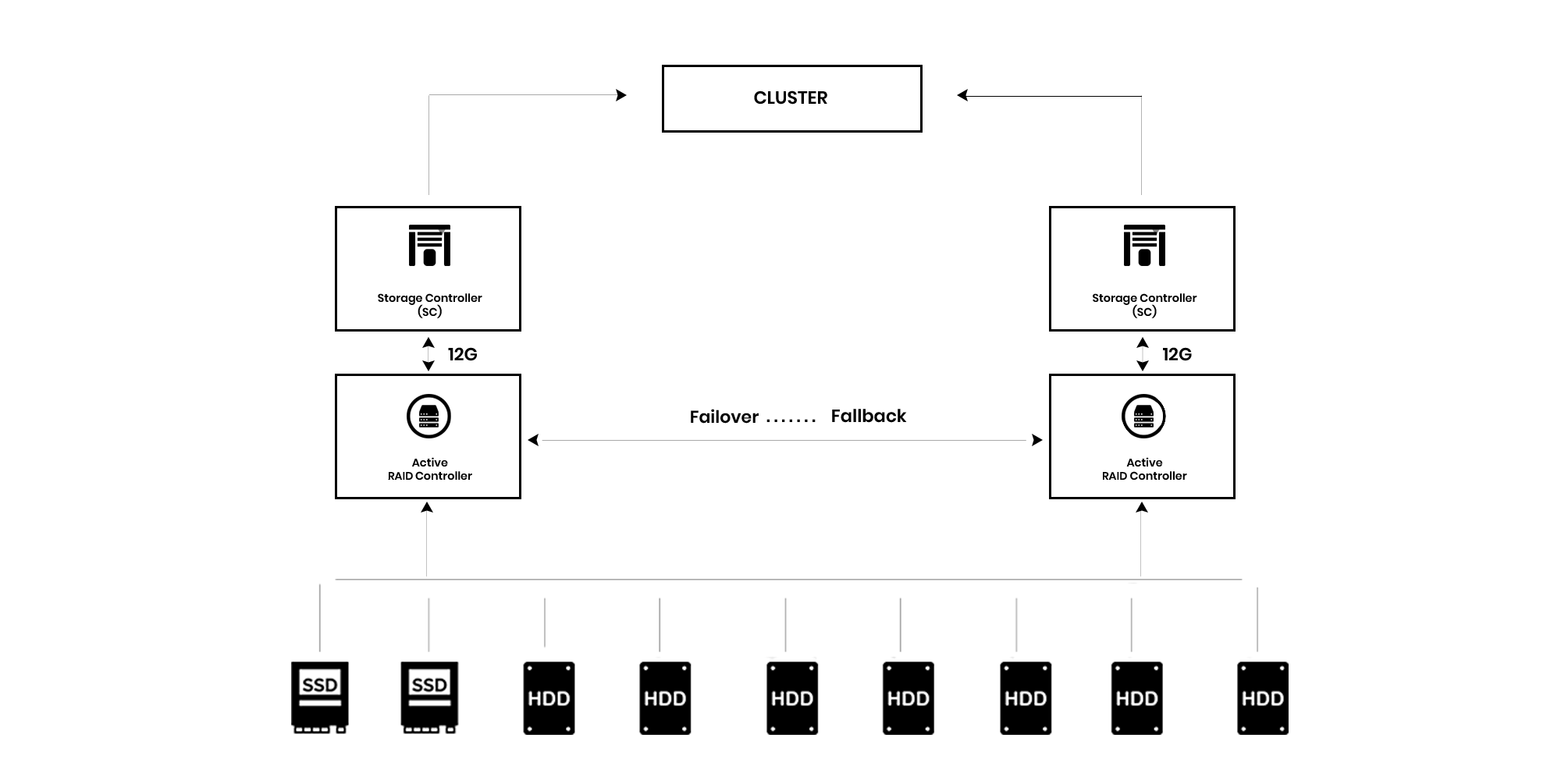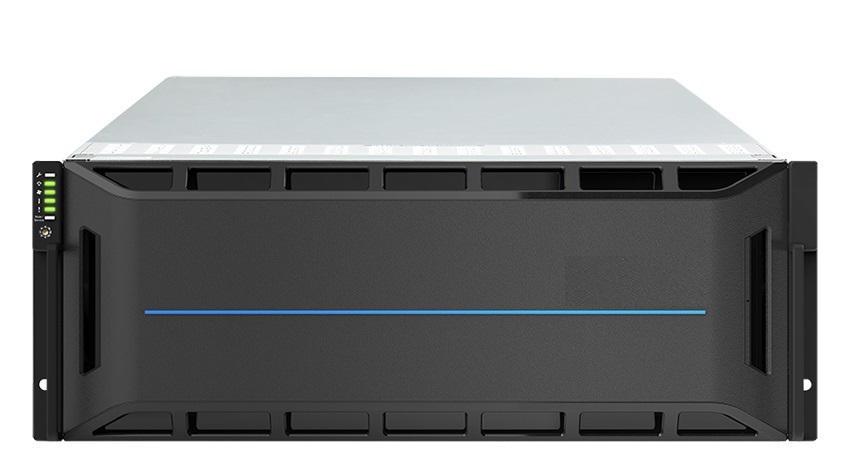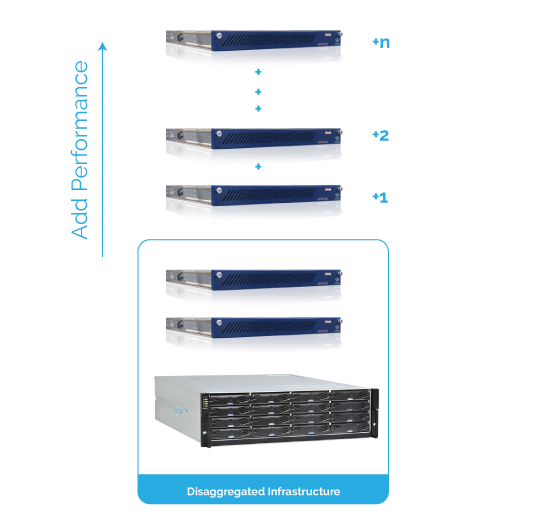This is the fourth article in a series of articles focused on exploring the hardware architecture of StoneFly’s innovative enterprise-grade data management solutions. In this article, we’ll discuss the hardware architecture of our disaggregated High Availability (HA) cluster appliances.
In our previous articles, we’ve discussed the hardware architecture and key components of our integrated appliances, dual node shared nothing appliances, and scale out appliances. If you’re looking for an aggregated infrastructure that delivers the “storage in a box” or “DR in a box” experience, we highly recommend reading the previous articles in the series.
To simplify your reading experience, following is the table of contents for the article:
Disaggregated HA Cluster Appliance Architecture Overview
StoneFly disaggregated HA cluster appliances comprise of three hardware chassis:
- Two Storage Controllers or HCI Controllers (if hyperconverged)
- One or More HA RAID Storage Expansion Arrays
The dual controllers deliver redundancy and multi-path access to the HA RAID array eliminating single point-of-failure and facilitating IOPS intensive workloads. The other benefit of using hardware independent controllers is the simplification of maintenance and replacement. Furthermore, if the storage controllers are in a separate chassis, then there’s no need for forklift upgrades. Our technology makes it possible to individually increase storage and performance capabilities.

This is how the internal architecture of our storage and backup and DR HA cluster appliances looks like:

There are two storage controllers or HCI controllers communicating with the dual RAID controllers in the HA RAID array to access, write, manage, and control the populated storage drives.
StoneFly disaggregated HA cluster appliances are highly scalable, easily manageable, and the best fit for demanding enterprise workloads.
Disaggregated HA Cluster Appliance Hardware Components
Let’s take a closer look at the different key components and hardware chassis in the disaggregated HA cluster appliances.
Storage Controllers or HCI Controllers

1U Storage Controller HCI Controller

2U Storage Controller HCI Controller
The two storage controllers or HCI controllers act as the management layer for the solution. The StoneFusion operating system™ or SCVM™ for hyperconverged infrastructure solutions, runs on dedicated NVMe. The storage controller or HCI controller chassis are available with support for iSCSI with an optional Fibre Channel upgrade.
For hyperconverged solutions (USS, DR365, DR365V, DR365U) the hypervisor, VMware, Hyper-V, KVM, or Citrix, also runs on the same NVMe that runs independently of the storage.
If it’s a backup & DR solution, the backup software is also installed on the HCI controller chassis.
StoneFly enterprise-grade solutions support 1U and 2U chassis for Storage Controller or HCI controllers. Value-tier disaggregated HA clusters support two 2U chassis only.
For more information about CPU memory, system memory and compatible network ports for the storage controller or HCI controller chassis, please contact us.
Dual Active/Active RAID Controllers
The RAID controllers are built-in the HA RAID Storage Expansion Array chassis. All HA RAID arrays have built-in dual active/active RAID controllers. In the event one fails, the system automatically fails over to the secondary RAID controller.
This adds another layer of redundancy for the RAID controller and ensures a highly robust and fault-tolerant storage or backup and DR system.
HA RAID Storage Expansion Array or HA RAID Array

The HA RAID array chassis has built-in active/active RAID controllers and it also houses the storage drives. Supported storage drives include enterprise SAS and SSDs (flash drives).
StoneFly disaggregated HA cluster appliances support HA RAID array chassis form factors ranging from 12-bay to 24-bay. The HA RAID arrays can be fully populated for hundreds of terabytes of storage capacity and users can add EBODs for additional storage capacities.
The HA RAID arrays are also available with support for 12Gb SAS and 16Gb Fibre Channel (FC) host ports.
HA RAID arrays are capable of supporting more than 400 additional drives with expansion units. The supported number of drives varies per appliance series and model.
Expandable Bunch of Drives (EBODs)
The EBODs for our disaggregated HA cluster appliances come with support for 12, 16, 24, and 60 enterprise SAS drives and SSDs. HA EBODs are easy to integrate and deliver the “plug and play” experience seamlessly adding more storage capacity to our disaggregated HA cluster appliances.

Hot-Swappable Storage Drives
The populated storage drives in the HA RAID arrays and the HA EBODs are hot-swappable. Users can seamlessly add more drives or replace existing drives without having to disrupt the system for longer periods of time.
Redundant & Hot-Swappable Power Supplies
The Storage Controllers / HCI Controllers, HA RAID arrays and the HA EBODs have redundant and hot-swappable power supplies. The redundant power supplies provide fault-tolerance enabling the disaggregated storage or backup & DR system to continue functioning even if a power supply fails.
The failed power supply can be easily replaced and removed without disrupting the system because they’re hot-swappable. So the maintenance process is quick and easy.
Highly Scalable with Scale Up & Scale Out Support
StoneFly disaggregated HA cluster appliances are truly unique in their ability to individually scale performance and storage capacity. As opposed to the forklift upgrade for legacy storage and backup and DR systems, users can add more performance and/or storage capacities in a budget-friendly and easy process.
Individually Enhance Performance Capabilities
The storage controllers / HCI controllers in StoneFly disaggregated HA cluster appliances start with Dual 10-Core Xeon Processors in each controller with an optional upgrade to 28-Core Xeon Processors. The standard system memory in each controller is 64GB and it can be upgraded to 6TB in each node.
Additionally, users can choose to add more storage controller / HCI controllers to the disaggregated system to add more processing capabilities or system memory.

Individually Add Storage Capacity
When fully populated, the disaggregated HA cluster appliances can store hundreds of terabytes of data. To add more storage capacity, users can add EBODs and store petabytes of enterprise data.

Standard enterprise-grade disaggregated HA cluster appliances can support more than 400 drives with expansion units (EBODs).
The number of supported storage drives varies depending on the appliance series and model. For more information, contact StoneFly support.
Scale Out: Add Performance & Storage Capacity
Besides adding performance and storage capacities individually, users can also choose to scale out (horizontal scaling) and add storage capacity and performance simultaneously.
There are two ways to scale out StoneFly disaggregated HA cluster appliances:
Adding Integrated Appliances
Integrated appliances have built-in processors, system memory, RAID controller, and storage drives. The addition of integrated appliances to the disaggregated HA cluster system adds performance and storage capacities.
Our disaggregated HA cluster appliances can scale out to virtually unlimited number of appliance nodes to store petabytes of enterprise data.
Adding Disaggregated HA Cluster Appliances
Instead of adding integrated appliance nodes, users can also add disaggregated HA cluster appliances to increase storage capacities and performance capabilities simultaneously.
StoneFly Disaggregated HA Cluster Appliances
Following are StoneFly’s disaggregated HA cluster appliances:
Data Storage Appliances:
- Voyager DX & Voyager FC SAN Cluster Appliances
- Unified NAS + SAN HA Cluster Appliances (USO-HA™)
- HA Cluster Hyperconverged Appliances (USS-HA™)
Backup & Disaster Recovery (DR) Appliances:
- Disaggregated Backup & DR Appliance (DR365-HA™)
- Veeam-Ready Disaggregated Backup & DR Appliance (DR365V-HA™)
- Universal Disaggregated Backup & DR Appliance (DR365U-HA™)
StoneFly’s range of disaggregated HA cluster appliances include enterprise and value-tier solutions. For more information about our different HA cluster storage or backup and DR solutions, contact StoneFly support.
Conclusion
Our disaggregated appliances offer flexibility, scalability and redundancy for data storage and backup & DR use-cases. For organizations looking to cater to IOPS intensive workloads and high availability requirements, our disaggregated HA cluster appliances are the best choice to make.
StoneCast – Podcast about StoneFly Disaggregated HA Cluster Appliances
We sat down with the CEO and Founder of StoneFly, Inc. to discuss StoneFly’s innovative disaggregated infrastructure.
Listen to the podcast session on the following channels:
SoundCloud | Podbean | Download the Audio
Interested in Our High Availability Solutions? Contact Us – We’re Ready for the Most Demanding Enterprise Workloads!
Phone: +1 510 265 1616
Email: sales@staging.stonefly.com
Connect with Us on Our Social Media Channels
Twitter: @stoneflyinc
Facebook: facebook.com/stoneflyinc
Youtube: youtube.com/stoneflyinc
Linkedin: linkedin.com/company/stonefly-networks
![composable-disaggregated-infrastructure-1374×1024[1]](https://staging.stonefly.com/wp-content/uploads/2019/09/composable-disaggregated-infrastructure-1374x10241.jpg)






